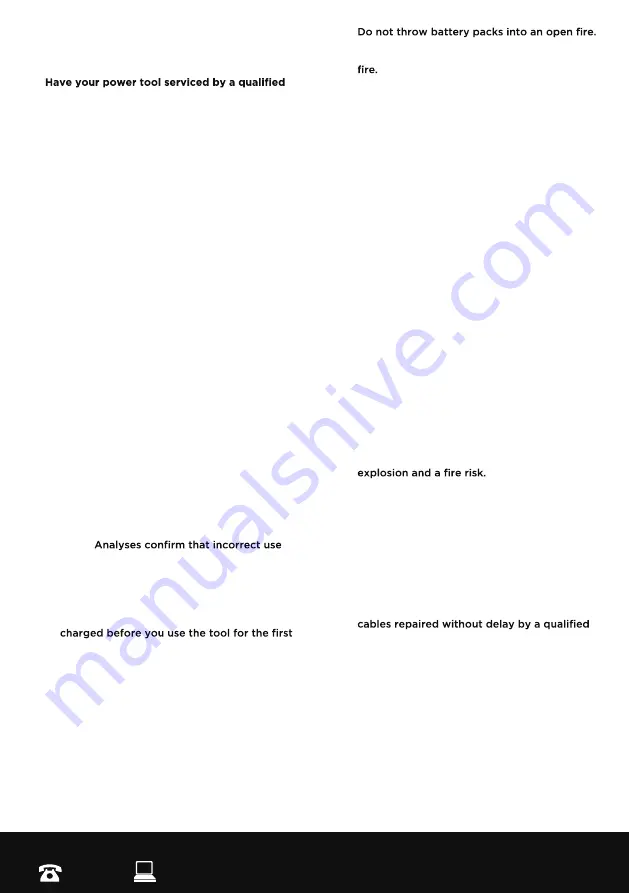
AFTER SALES SUPPORT
1300 922 271
service.australia@einhell.com
6
those intended could result in a hazardous
situation.
5. Service
a.
repair person using only identical replacement
parts.
This will ensure that the safety of the
power tool is maintained.
6. Recommendation
We recommend that the tool always be supplied via
residual current device with a rated residual current
of 30 mA or less.
2. Additional Safety Rules
Hold the equipment by the insulated handles when
carrying out work during which the screw or the
plug-in tool could strike concealed power cables.
Contact with a live cable may also make the metal
parts of the equipment live and cause an electric
shock.
We pay a great deal of attention to the design
of every battery pack to ensure that we supply
you with batteries which feature maximum power
density, durability and safety. The battery cells have
a wide range of safety devices. Each individual cell
is initially formatted and its electrical characteristic
curves are recorded. These data are then used
exclusively to be able to assemble the best possible
battery packs.
Despite all the safety precautions,
caution must always be exercised when handling
batteries. The following points must be obeyed at
all times to ensure safe use.
Safe use can only be guaranteed if undamaged
cells are used. Incorrect handling can cause cell
damage.
Important!
and poor care are the main causes of the damage
caused by high performance batteries.
Information about the battery
1.
The battery pack supplied with your cordless
tool is not charged. The battery pack has to be
time.
2.
For optimum battery performance avoid low
discharge cycles. Charge the battery pack
frequently.
3.
Store the battery pack in a cool place, ideally
at 15°C and charged to at least 40%.
4.
Lithium-ion batteries are subject to a natural
ageing process. The battery pack must be
replaced at the latest when its capacity
falls to just 80% of its capacity when new.
Weakened cells in an aged battery pack are
no longer capable of meeting the high power
requirements and therefore pose a safety risk.
5.
There is a risk of explosion!
6.
Do not ignite the battery pack or expose it to
7.
Do not exhaustively discharge batteries.
Exhaustive discharge will damage the battery
cells. The most common cause of exhaustive
discharge is lengthy storage or non-use of
partly discharged batteries. Stop working as
soon as the performance of the battery falls
noticeably or the electronic protection system
triggers. Place the battery pack in storage
only after it has been fully charged.
8.
Protect batteries and the tool from overloads.
Overloads will quickly result in overheating
and cell damage inside the battery housing
without this overheating actually being
apparent externally.
9.
Avoid damage and shocks. Replace batteries
which have been dropped from a height of
more than one meter or which have been
exposed to violent shocks without delay, even
if the housing of the battery pack appears to
be undamaged. The battery cells inside the
battery may have suffered serious damage.
In this respect, please also read the waste
disposal information.
10. If the battery pack suffers overloading and
overheating, the integrated protective cut-
off will switch off the equipment for safety
reasons.
Important!
Do not press the ON/OFF
switch any more if the protective cut-off has
actuated. This may damage the battery pack.
11.
Use only original battery packs. The use
of other batteries may result in injuries,
Information on chargers and the charging
process
1.
Please check the data marked on the rating
plate of the battery charger. Be sure to
connect the battery charger to a power
supply with the voltage marked on the rating
plate. Never connect it to a different mains
voltage.
2.
Protect the battery charger and its cable from
damage and sharp edges. Have damaged
electrician.
3.
Keep the battery charger, batteries and the
cordless tool out of children’s reach.
4.
Do not use damaged battery chargers.
5.
Do not use the supplied battery charger to
charge other cordless tools.
6.
In heavy use the battery pack will become
warm. Allow the battery pack to cool to room
temperature before commencing with the
charging.
7.
Do not over-charge batteries. Do not exceed
the maximum charging times. These charging
times only apply to discharged batteries.
Frequent insertion of a charged or partly
MODEL NUMBER: BT-CD 10.8 Li,
01/13






























